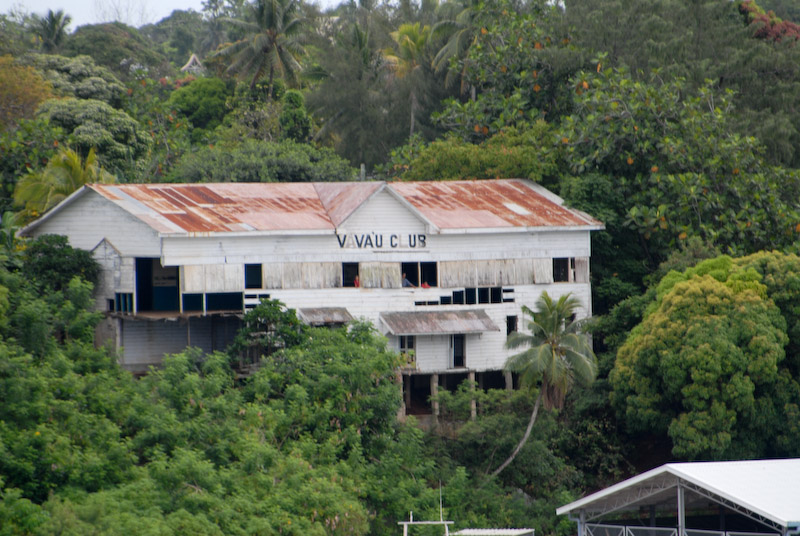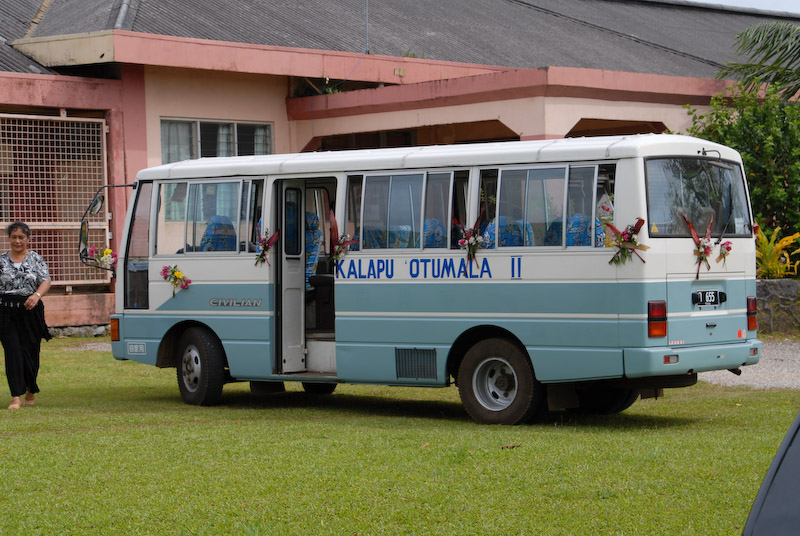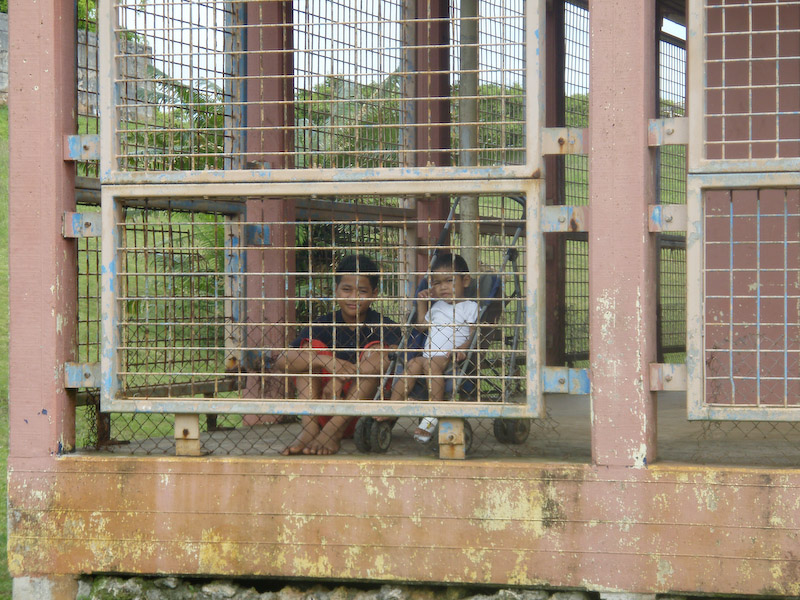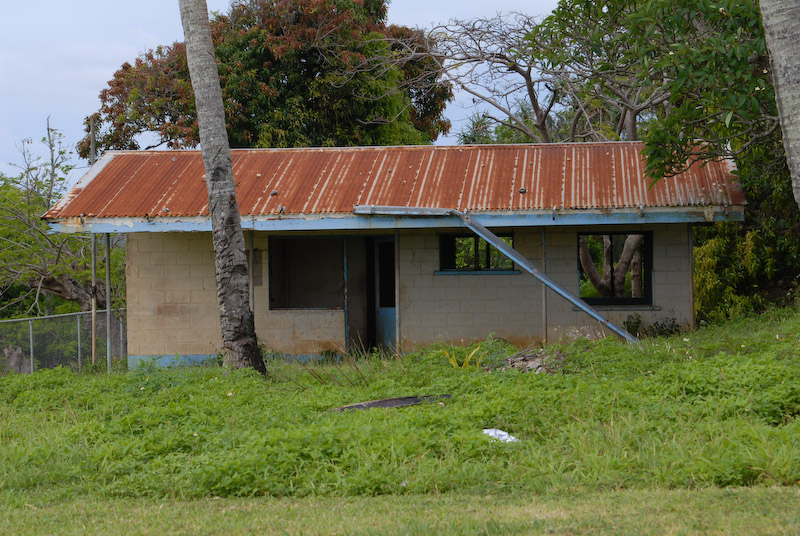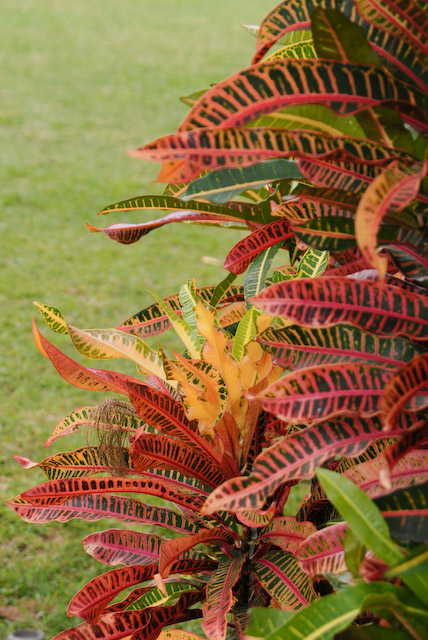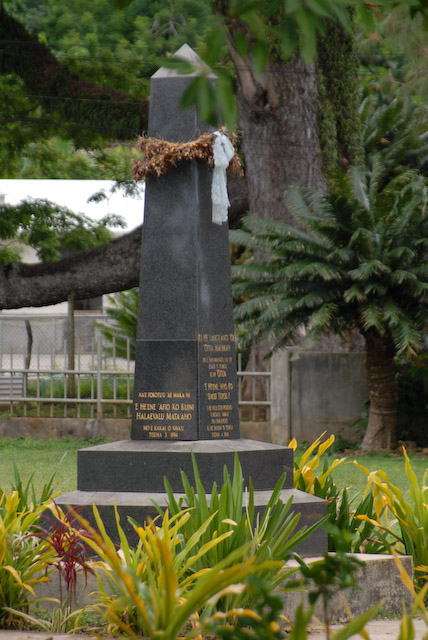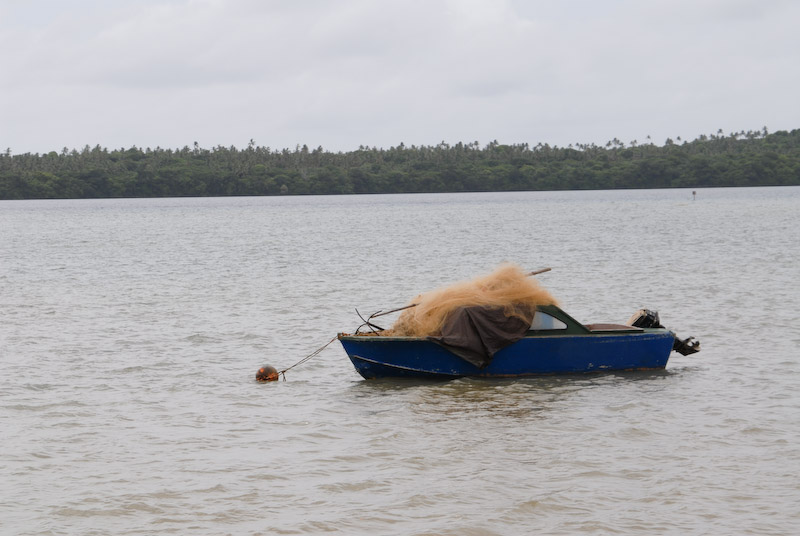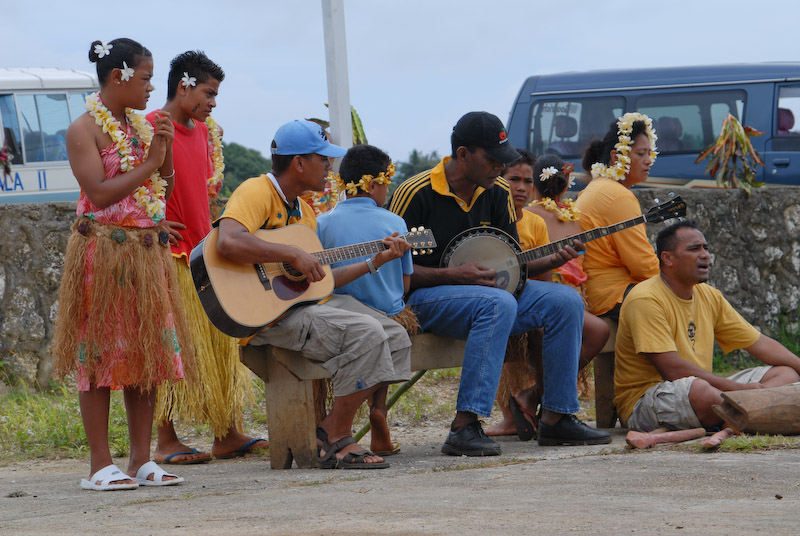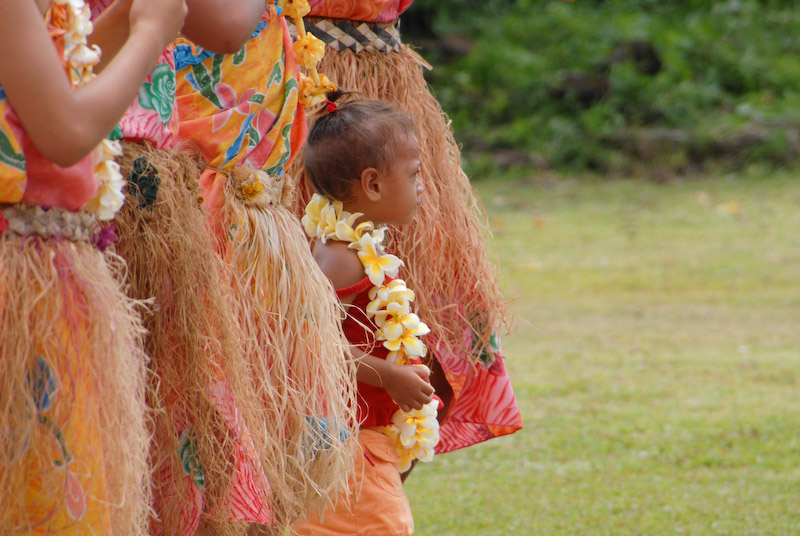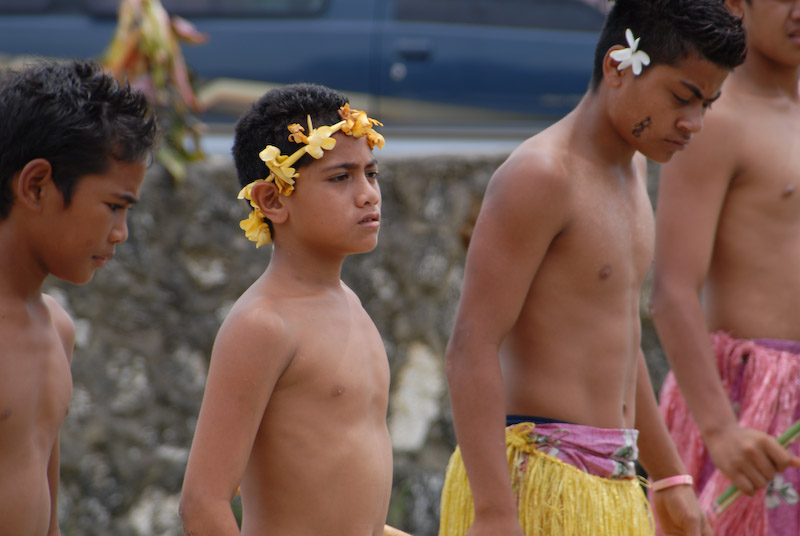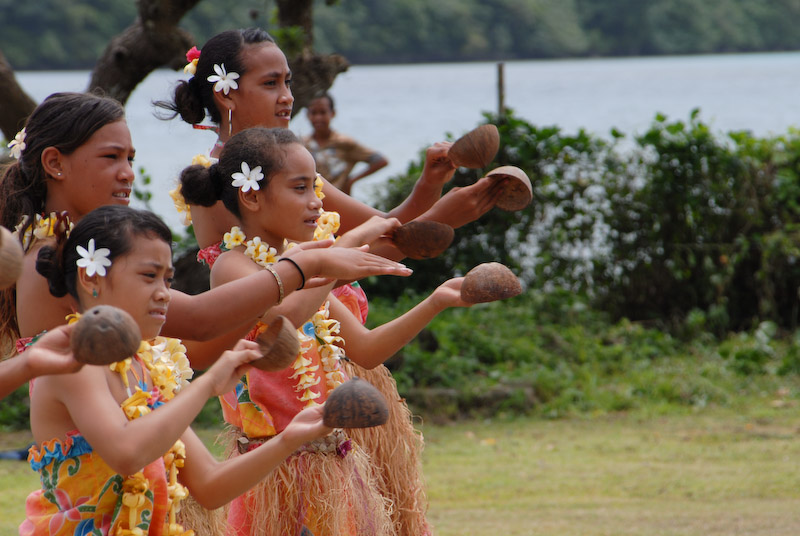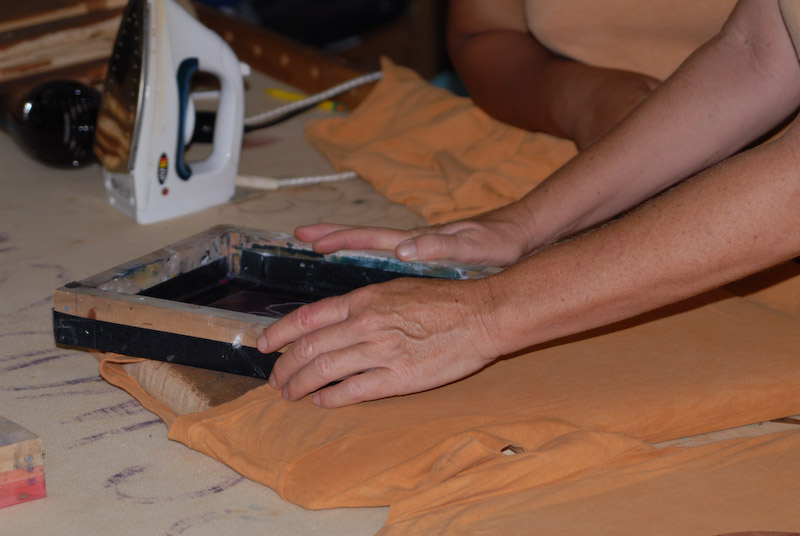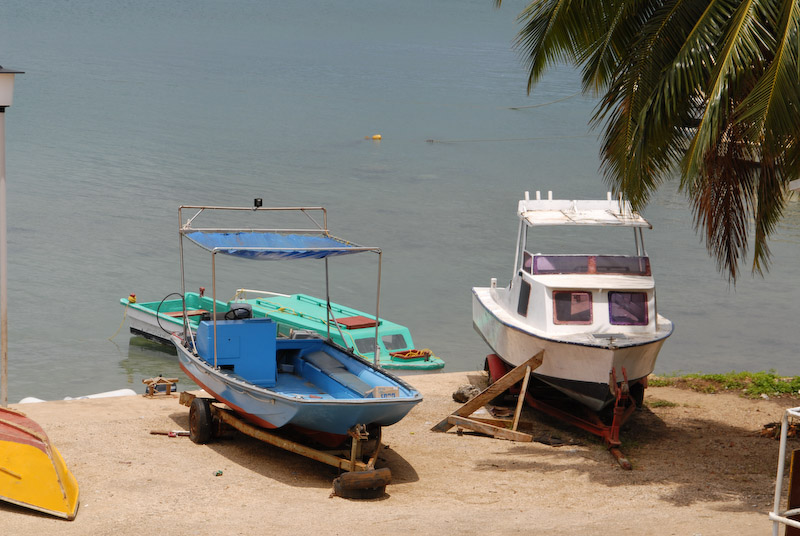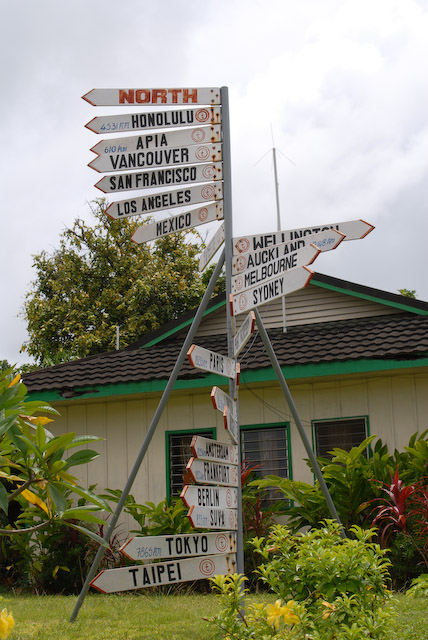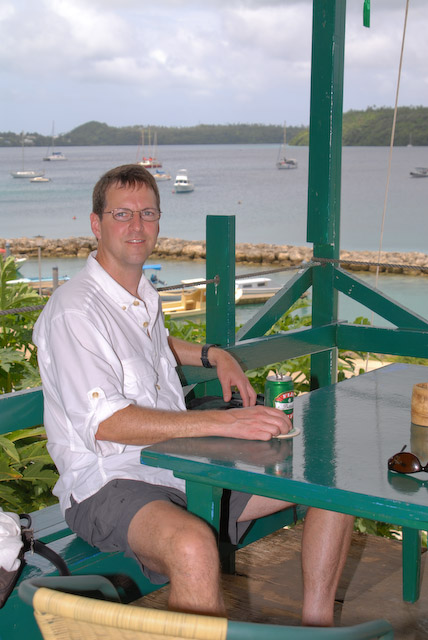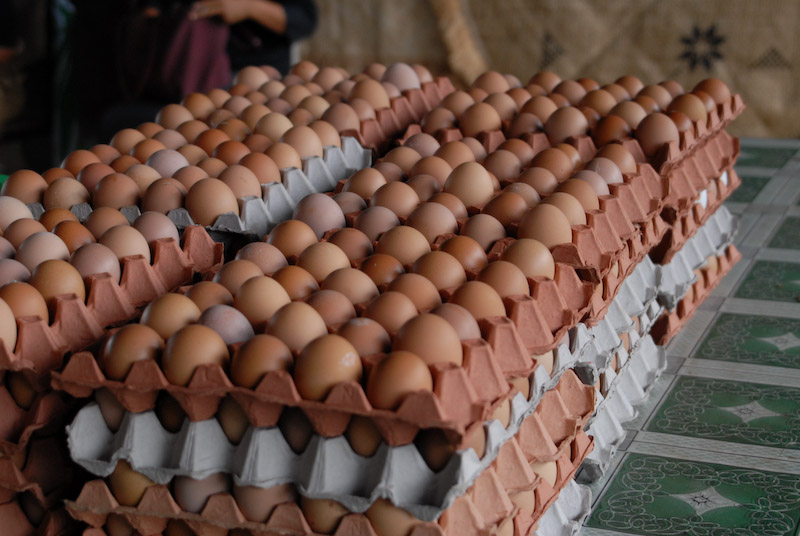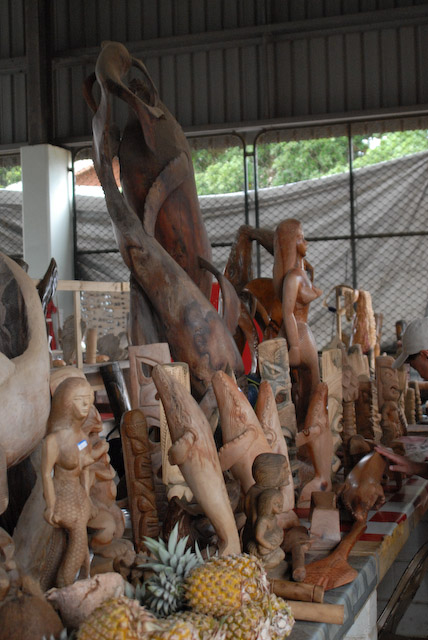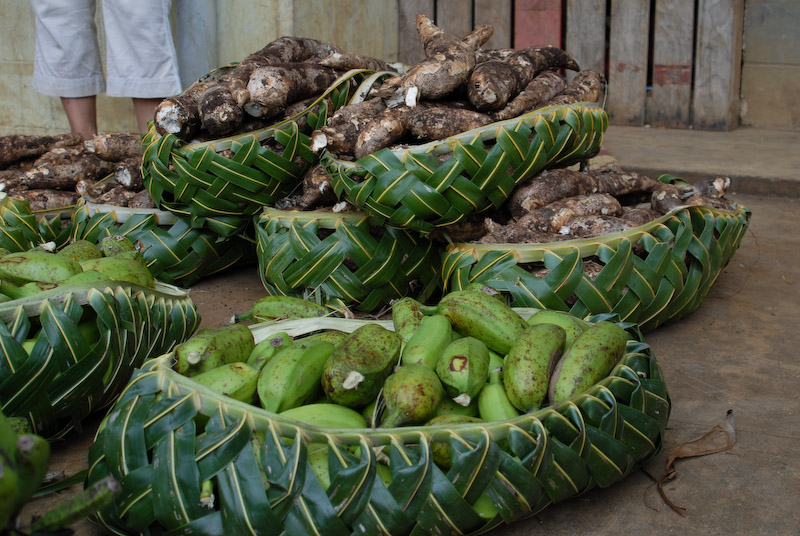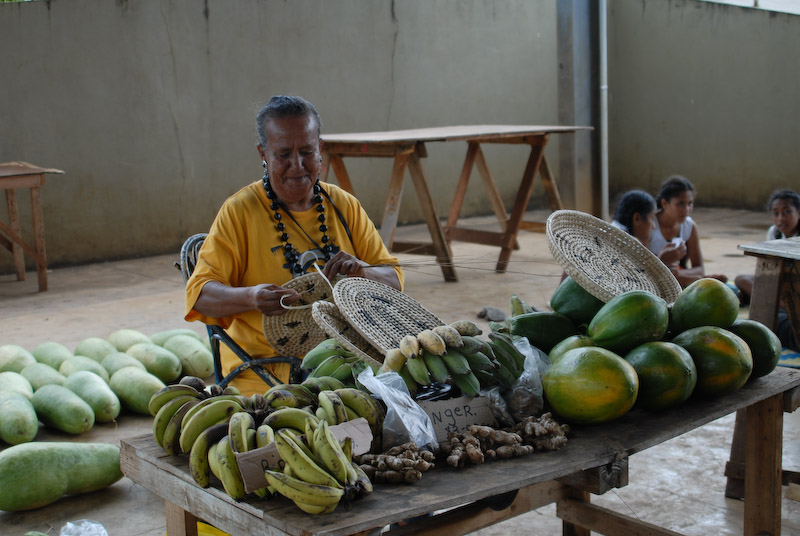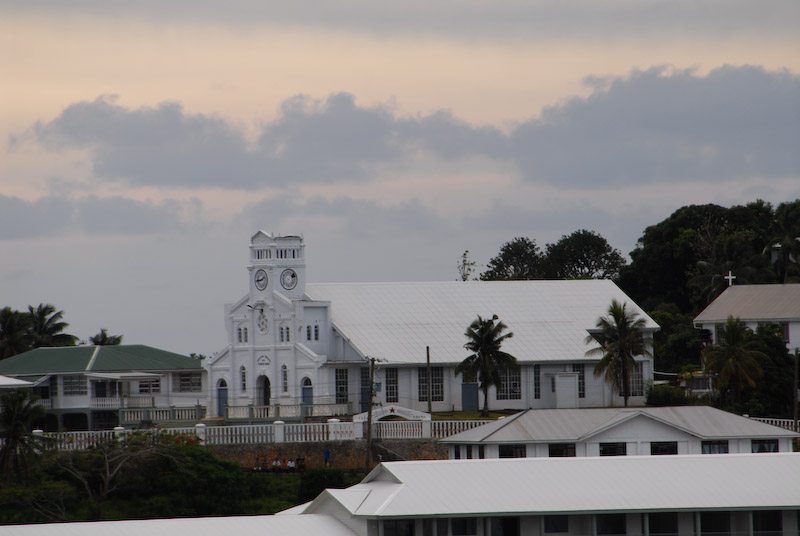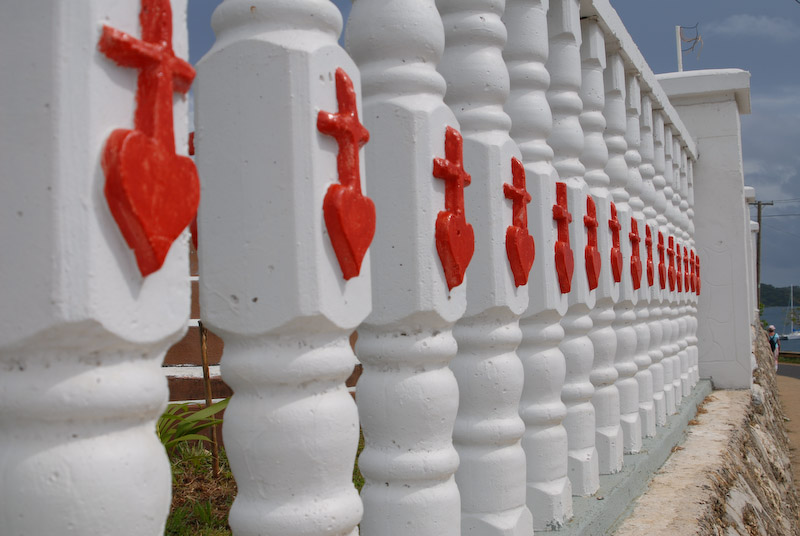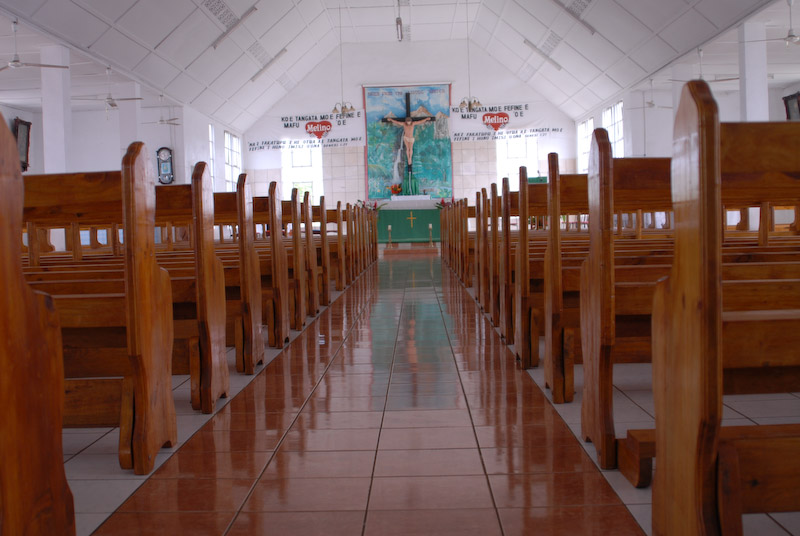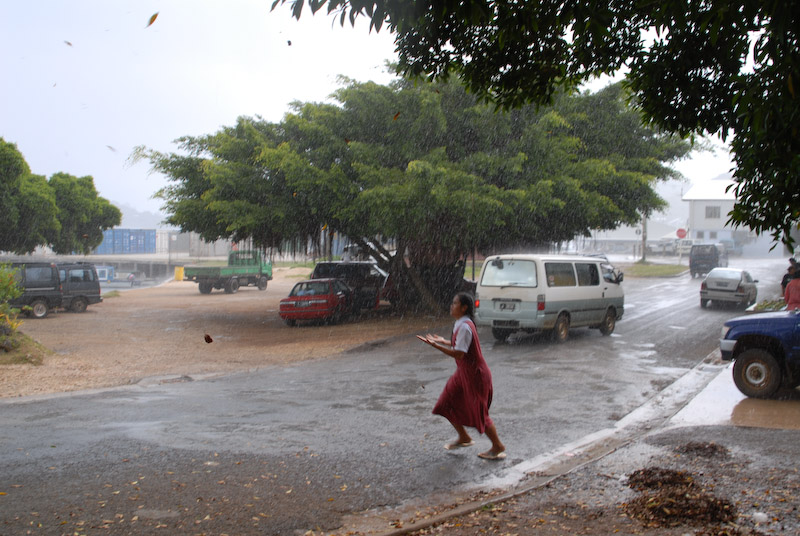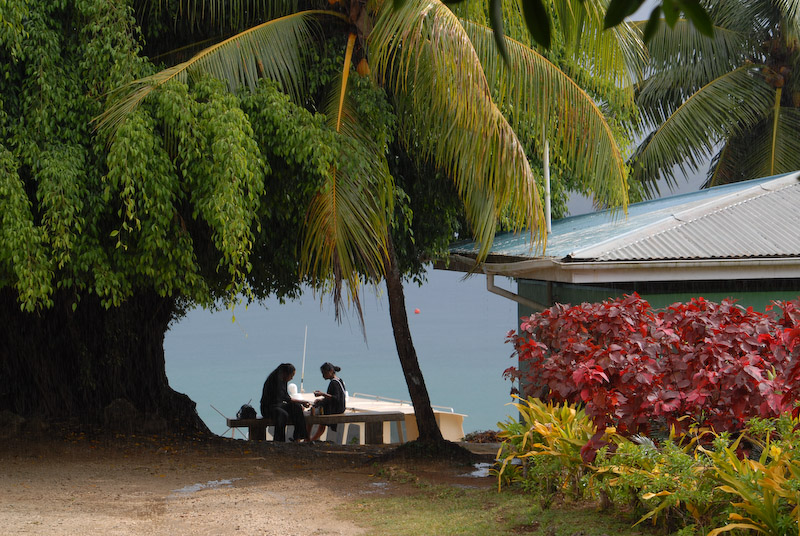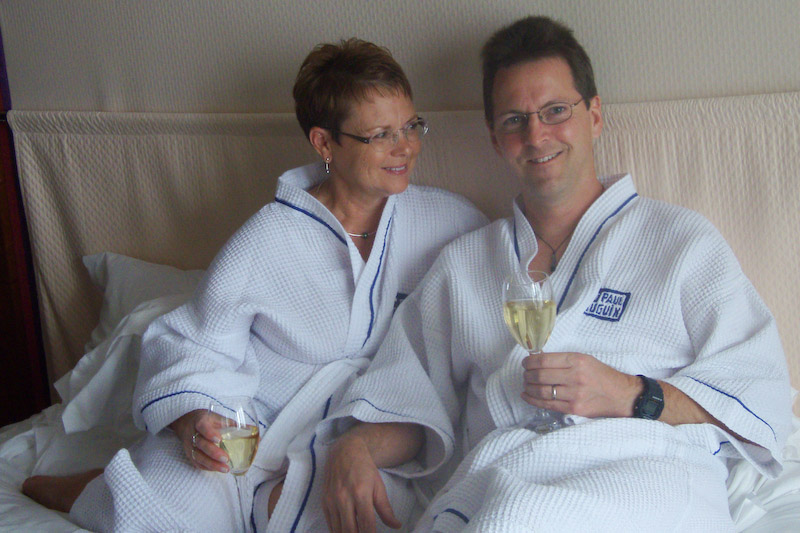Vava’u, Tonga
We both woke up early and went to La Palette for coffee. We watched as the Paul Gauguin threaded its way through a narrow channel to the port of Neiafu, Tonga on the Vava’u island group. We got the feeling that not many cruise ships visited the area. As the captain carefully navigated the channel, the locals came out of their homes and waved at us. We waved back.
Even early in the morning, the weather was hot and muggy. I checked the weather forecast in the reception area. It predicted a uniform 82 degrees Fahrenheit with 85% humidity. And a chance of showers.
Scenic and Cultural Vava’u
After breakfast we boarded the tender for our shore excursion, “Scenic and Cultural Vava’u”. At the dock we passed through an informal immigration checkpoint (just a gate with an attendant) and were loaded onto a small bus. Our guide was a local woman. We would find out later she had seven children and a young granddaughter who lived in Salt Lake City, Utah. She also sold hand-made black coral jewelry, and Chris bought a piece from her for US$5.
Our first tour stop was a college atop a hill overlooking Neiafu and the harbor. When we arrived, though, the gate was locked. After a quick check with a nearby student, our guide found out we couldn’t go on the grounds because the students were in the middle of exams. The driver backed our bus down the hill and we continued on.
As we drove we passed ramshackle houses, all of which had lines full of drying clothes. The front yards were littered with toys and appliances. Many of the houses had small gardens or pigpens. We were taken aback by the apparent poverty of the general population. However, the people were friendly and seemed genuinely happy and healthy. The decay just seemed to be part of the environment.
Our next stop was another hilltop viewing area. It was at Prince Ngu Hospital, which had been built with Australian help. From the lawn of the facility we could overlook the whole town of Neiafu. The hospital rooms had doors that opened onto a porch that encircled the building. The porch was separated from the lawn by a fine-mesh fence. We learned later the fence was there to prevent family and friends from giving outside food to the patients, so the doctors could monitor their diets. Our guide said we could go inside the hospital, but neither of us felt comfortable invading the privacy of the patients. Instead we took pictures and talked with the guide.
After about twenty minutes at the hospital, we loaded up onto the bus again and drove back through Neiafu. We stopped at a memorial park where our guide wanted to give us some history, but the gates of the park were locked. After some more driving, we ended up on the far side of the island for tea and a dance demonstration.
It was good to get off the bus. Even though it had open windows, it was uncomfortably hot when we weren’t moving. We were glad for the overcast sky that at least kept the sunshine from making things even hotter.
Our abbreviated tour through Neiafu had apparently taken less time than it was supposed to. When we arrived for the dance demonstration and tea, very little was ready for us. There were chairs, benches, and tables under a large marquee, but the tables were empty. We also noticed that the dancers were still in their street clothes.
Shortly two local women came out and began demonstrating local crafts. One of them beat mulberry bark against a log to make tapa cloth. Another pulverized a local root to make kava powder. Kava is used to make an intoxicating drink that is very popular with many South Pacific adults.
While the demonstrations were going on, other men and women set up tea. There was hot water for steeping tea bags or making instant coffee. There were also plates of fresh fruit, bread, and cakes. It was all yummy.
Ordinarily, the dancers and musicians would have been high-school-age kids. Unfortunately, those regulars were in school taking exams. In their place were the junior dancers and adult musicians. These dancers’ ages ranged from about 10 to 14. Despite the youth of the dancers, many of them were very good. They also looked like they were having fun, and they remained professional even when they weren’t actively dancing – not goofing around the way we had seen some other dance groups do. It was the best dance performance we had seen since the Intercontinental in Tahiti.
A highlight of the show was a toddler who wanted to be part of the goings on. This little girl looked to be about a year and a half old, and she would join the girl dancers and sway along with them. She brought a light note and a lot of cuteness to the performance.
Shopping
After the show we loaded back on the bus for a short drive into town. Before we reached the pier, the guide asked if anyone wanted to shop. Chris certainly did, so we got off the bus with about five other passengers in the middle of town. We were a short walk from the pier.
We looked through hand crafts in several stores and also shopped at a tee shirt store named Tropical Tease. We found out the owners were a couple who had emigrated from southern California ten years before. After sailing for four years, they settled in Neiafu and opened their store. It specialized in original screen-print designs and red-dirt shirts – polo and tee shirts stained red with the local soil. I bought a red-dirt tee shirt with a map of Vava’u on the back. Chris bought a bone necklace with a spiral design at one of the other shops.
As we walked through town we noticed a quiet bar called Bounty Bar. We could see the deck had a nice view of the harbor, so we stopped in for a drink. I had a Fiji Bitter and Chris drank a Sprite while we cooled off in the breeze and enjoyed the view. When we were rested, we made our way closer to the pier, stopping at a market that sold local produce and handcrafts. We saw pineapples, bananas, eggs, and other foods we recognized. We saw a lot of food that was not familiar to us: taro, plantains, tapioca, and more items we never did identify. We spent most of our time looking at the handcrafts, though.
All of the prices were in Tongan currency, the pa’anga. The exchange rate was roughly 2 pa’anga per US dollar. Every merchant we met was glad to take either pa’anga or dollars.
We bought a necklace for me, even though I don’t usually wear any jewelry. It was a very simple, rectangular piece of oyster shell that was silver with a black tip. As we were looking through some of the other crafts, a piece caught my eye. It was a carving in ebony of a face in bas relief. It was mounted on a woven mat with feathers tucked behind the carving to look like hair. After bargaining on the price, I made a quick trip to the ATM to get more cash and bought it. It would look good in our guest bathroom once it was properly framed.
After making our purchases, we caught the next tender back to the ship. We took a dip in the pool and had lunch at the Grill.
More Shopping
We still had some pa’anga left, and we needed to spend them before we left Tonga. We cleaned ourselves up and caught another tender to shore. We bought a carved swordfish bill at the market to go with the ebony face, and then walked through the town again taking pictures.
By that time, there were a lot of school students hanging around. Many of the schools are run by different Christian denominations. Each one – Catholics, Methodists, Mormon, Jehovah’s Witnesses – has its own color for the school uniforms. The government-run schools have yet another color. We saw students in purple, green, and orange skirts.
On our way back to the ship, we noticed fat raindrops starting to fall. The rain quickly developed into a torrent, so we rushed under a large tree for shelter. The tree kept us fairly dry, and we shared the shelter with Rob and Al from the ship and a local woman. Most of the locals either went about their business in the rain or sat under umbrellas until it stopped less than ten minutes later.
We caught the 4:00 tender back to the Paul Gauguin, showered, rested, had some wine, and watched TV. Just before 5:00, we noticed the ship was moving. That seemed odd, because the tender schedule had listed the last departure from Neiafu as 5:00. It turns out that the captain had rushed the schedule because the tide was going out. The entry into the harbor had been pretty tight, and he didn’t want to run the risk of getting stuck or running aground as he exited. We heard rumors later that he had vowed not to take a ship the size of the Paul Gauguin back into that harbor again.
The Storms Begin
We had reservations in La Veranda for dinner. While we ate – mahi mahi for Chris, rack of lamb for me – a big storm blew up. I could see large flashes of lightning outside the windows. Chris sat with her back to the windows, and she thought the flashes were just from cameras of the other diners. We found out from Tom and Pat later that the storm had been quite an adventure for diners at the Pacific Grill. The Grill is protected from the weather by Plexiglas partitions and a waterproof awning, but it is not completely enclosed. The wind whipped through the restaurant making it a challenge to eat there, and the rain washed under the partitions and penetrated small gaps in the awning. Many diners gave up, but Tom and Pat stuck it out. The light show was too impressive to miss.
After dinner we listened to Kemble at the piano bar. That is where we talked to Tom and Pat about their dinner adventure. Later Fred joined us. He had lost his stake at the blackjack table, but Wendy and Katherine were still playing. We watched Wendy and Katherine for a while, and then went back to our room at 9:30. We watched more of The Incredibles bonus disc, set our clocks back an hour one last time, and turned the lights out at 9:30 Fijian time.
